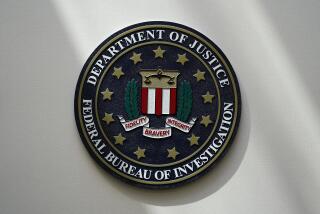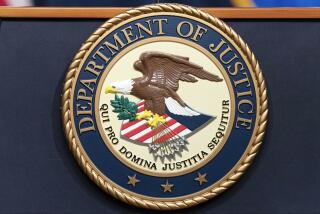Al Qaeda Had 10-Plane Plot for U.S., Report Says
WASHINGTON — The Sept. 11 terrorist attacks were a scaled-down version of a more audacious plot that involved the hijacking of 10 planes to strike targets on both coasts, including the tallest buildings in California and Washington state, according to a report released Wednesday by the staff of the commission investigating the attacks.
The plan, conceived by Khalid Shaikh Mohammed, who was to have piloted one of the aircraft, received a lukewarm response from Al Qaeda leader Osama bin Laden and was scrapped as unfeasible, the report said.
Investigators also found that disagreements among the 19 hijackers and their handlers were widespread and included feuding over personnel and timing as well as targets, a depiction that contrasted with prevailing views of the plotters as a well-oiled terrorist machine.
Among the problems: One of the pilots of the doomed jets developed second thoughts in the weeks before the attacks. The report also found that some senior Al Qaeda officials opposed the Sept. 11 operation partly because they were concerned that the U.S. would respond militarily.
The revelations were among findings by commission staff released Wednesday. The official report of the Sept. 11 commission is due July 26.
The findings, issued as part of a final round of public hearings, were based in large part on previously undisclosed interviews with Sept. 11 mastermind Mohammed and Ramzi Binalshibh, a key coordinator for the plot, both of whom are in U.S. custody.
Mohammed told investigators that his initial proposal involved hijacking 10 planes to attack targets on the East and West coasts of the United States. He claimed that plans also called for crashing planes into CIA and FBI headquarters, unidentified nuclear power plants and unspecified skyscrapers in the West.
Among evidence offered Wednesday was a report, previously disclosed in 2002, that an unidentified CIA source told the agency three months before the attacks that Mohammed had been preparing operatives to go to the United States. The information was shared with U.S. law enforcement agencies, but witnesses were unable to say what was done with it.
The commission staff also generated an estimated price tag for the attacks -- $400,000 to $500,000, excluding the cost of running camps in Afghanistan, where the hijackers were trained.
“It is absolutely staggering to me the twisted cost-benefit ratio of what Al Qaeda pulled off on Sept. 11,” commission member Timothy J. Roemer said at the hearing Wednesday, adding that he despaired at the resiliency the terrorist network had shown since the attacks. “They continue to float and spread like mercury across a mirror all over the world.”
The commission has previously examined intelligence breakdowns by the CIA and FBI leading up to the attacks, among other topics, and is expected to scrutinize what the Pentagon and aviation regulators did in response to the attacks in a final hearing today.
Among other revelations, the hearings Wednesday clarified the alleged role of Zacarias Moussaoui, the French national and Al Qaeda operative who was arrested in Minnesota a month before the attacks after attending flight school. He is being prosecuted in federal court in Virginia on conspiracy charges.
Commission staff members said that Moussaoui was considered a replacement pilot after one of the original 19 appeared on the verge of backing out, and that he was wired $14,000 to cover the cost of an intensive flight-simulator course in early August 2001.
The staff report said Mohammed ordered the money sent in a coded message: Send “the skirts” to “Sally.”
The staff concluded that Moussaoui’s arrest “may have prevented him from joining the 9/11 operation.”
Edward MacMahon Jr., Moussaoui’s lawyer, said Wednesday the statements by the staff were “misleading and incomplete.”
His view was supported by the final congressional Report of the Joint Inquiry Committee on the attacks issued in 2002, which said that Moussaoui was never intended to be part of the Sept. 11 operation and “was slated instead to participate in a so-called ‘second wave’ of attacks on the West Coast.”
There was no immediate explanation for the discrepancy.
The hearing also shed new light on an illegal immigrant, Mohdar Abdullah, who befriended two San Diego-based hijackers, Nawaf Alhazmi and Khalid Almihdhar, helping them obtain driver’s licenses and enroll in schools.
The hearings underscored the ease with which the hijackers moved about the United States and became assimilated in the culture.
The testimony of the staff was punctuated with photographs of the hijackers withdrawing money from cash machines taken by security cameras and a photocopy of a speeding ticket that one of the hijackers was issued while driving to his final staging point in New Jersey.
Another photo, taken by an airport security camera, caught plot leader Mohamed Atta running to catch a commuter flight in the Portland, Maine, airport on the morning of the attacks. The flight was destined for Boston, where he then boarded and hijacked one of the planes that struck the World Trade Center.
According to the commission staff, Mohammed told investigators that he first proposed the idea of attacks against the United States to Bin Laden in 1996, but that the plan did not get rolling until three years later, when Bin Laden began identifying potential suicide operatives and targets.
The centerpiece of the plan, Mohammed said, was a plane that he was to pilot. Instead of crashing the plane into a target, he told investigators, he intended to kill every adult male on board, contact the media from the air and make a speech denouncing U.S. policies in the Middle East after he landed.
The plan, he told investigators, received only a “lukewarm response” from Al Qaeda leadership because of its scale and complexity.
Mohammed also proposed splitting the plot into two pieces, hijacking U.S. planes flying Pacific routes from Southeast Asia and exploding them in midair, at the same time that hijacked planes were being crashed into U.S. targets.
But Bin Laden found that idea problematic as well, canceling the Southeast Asia prong in April or May of 2000 because he believed it would be “too difficult to synchronize the hijacking and crashing of flights on opposite sides of the globe,” staff members said.
The report also revealed that some of the conspirators grew skittish about the plans in the final weeks and days of preparation and may have considered dropping out.
Among the possible defectors was Ziad Samir Jarrah, the suspected pilot of the hijacked plane that crashed in Pennsylvania. The report indicates that Jarrah decided not to withdraw after “an emotional conversation” with Binalshibh, who “encouraged Jarrah to see the plan through.”
The report found that the precise date of the attacks was not chosen until about three weeks before Sept. 11, and was itself a point of debate.
Bin Laden pressured Mohammed for months to advance the attack date, starting as early as mid-2000, the report said.
At one point, Bin Laden pressed Mohammed to stage the attacks on May 12, 2001, the seven-month anniversary of the bombing of the U.S. destroyer Cole.
At another point, he requested a date in June or July 2001 to coincide with an announced visit to the White House by Israeli leader Ariel Sharon. Mohammed responded that the hijacker teams were not ready.
Ultimately, the report found, Atta selected a date after the first week of September so that Congress would be in session.
The report found that the U.S. Capitol, as well as the White House, were being considered as targets and that, as late as two days before the attacks, “the conspirators may still have been uncertain about which Washington target they would strike.”
Thomas H. Kean, chairman of the panel formally known as the National Commission on Terrorist Attacks Upon the United States, told reporters after the hearing Wednesday that he was impressed that the conspirators managed to follow through with the attacks, despite the operational difficulties and internal disagreements.
More to Read
Sign up for Essential California
The most important California stories and recommendations in your inbox every morning.
You may occasionally receive promotional content from the Los Angeles Times.









